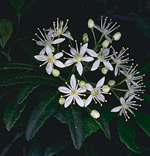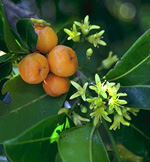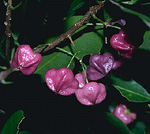 |
This is a large family widely distributed in the tropics and warmer temperate parts of the world. It is particularly rich and diverse in South Africa, and in Australia where there are many species in the rainforests and monsoon forests of northern and eastern Australia, and many others in heathlands and forests in the south-west and south-eastern temperate regions. Relatively few occur in the arid region.
Characteristic features of the family Rutaceae in Australia include: - trees or shrubs, occasionally woody climbers or very rarely almost herb-like
- leaves alternate or opposite, simple to pinnately or palmately compound, often with a slight or strong odour when crushed and with prominent or obscure gland-dots in the leaves and on the flower buds
- flowers regular, usually with 5 small sepals, 5 free or fused petals and 5 or 10 stamens
- ovary superior, usually borne on, embedded in, or surrounded by a prominent nectary-disc, sometimes of several more or less free carpels but with the styles fused
- fruit usually of capsules, sometimes fragmenting as they split, or berries with a thick rind and juicy pulp, or drupes
Description
Evergreen, deciduous or semi-deciduous trees, or shrubs,
or woody vines climbing by twining stems or hooks, very rarely perennial
terrestrial herbs. If herbs then perennating by taproots. Leaves sometimes
±absent. Stems unarmed, or rarely with prickles or spines arising
from the stem surface or the leaf axils; internodes solid, spongy or pithy,
terete, oval or slightly flattened, or distinctly angular, rarely strongly
flattened. Internal secretions not obvious or of essential oils or resin.
Plants glabrous, or with simple, dendritic or stellate, non-glandular,
unicellular or uniseriate hairs or peltate scales. Leaves well developed
or rarely much reduced (i.e. to scales, etc.), alternate and spiral, or
opposite, or in whorls of 3 or 4, cauline if herbs, petiolate, subsessile
or sessile. Stipules rarely present, distinct and free from the petiole,
bristle-like, persistent; stipellae absent. Lamina simple or once compound,
rarely bicompound, unifoliolate, bifoliolate, ternate, paripinnate or
imparipinnate, symmetric; lamina/leaflets filiform, acicular, subulate,
linear, lanceolate, ovate, elliptic, oblanceolate, oblong or orbicular;
base cuneate, attenuate, rounded, cordate, oblique, or conspicuously asymmetric;
margins entire, crenate, dentate, serrate or sinuate, ±flat, revolute,
recurved, involute or incurved; one-veined, or the venation pinnate, or
parallel, with the midrib conspicuous or inconspicuous, and the tertiary
venation reticulate or not; surfaces usually punctate; herbaceous or leathery;
distinctive odour aromatic or foetid, rarely absent. Domatia absent, or
comprised of pits or pockets in the vein angles. Male and female flowers
occurring on separate plants, or with all the flowers bisexual. Inflorescences
terminal, axillary, cauliflorous or ramiflorous, consisting of racemes,
panicles, corymbs, thyrses, umbels, dichasial or monochasial cymes, or
solitary flowers. Bracts and bracteoles present or absent. Pollination
by insects or birds. Flowers odourless, fragrant or malodorous, sessile
or stalked. Floral disc present or rarely absent; nectaries present on
the disc. Perianth regular, of 2 dissimilar whorls or rarely vestigial,
imbricate or valvate, or rarely open in bud. Calyx segments free or fused,
with 36 sepals or lobes; calyx cup-shaped or bell-shaped, or rarely tubular,
herbaceous or papery. Corolla segments free or fused, with 36 petals
or lobes, alternating with the sepals or calyx lobes; corolla bell-shaped
or tubular, white, cream, yellow, red, pink or green, without contrasting
markings, membranous, papery or succulent; claws absent; lobes ±entire,
or ciliate or fimbriate. Fertile stamens 35, 8 or 1060, opposite to,
or both opposite to and alternating with, or not clearly correlated with
the sepals or calyx lobes, free or rarely at least partly fused to the
corolla, free of the ovary and style, distinct from each other or rarely
fused by their filaments into an open or closed tube, all ±equal
or distinctly alternating long and short. Staminodes present or absent.
Staminal filaments sometimes distinctly flattened. Anthers dorsifixed
or basifixed, versatile or not versatile, opening sideways or inwards
by longitudinal slits, 2-celled; appendages absent or apical. Ovary superior,
sessile or rarely stalked. Carpels (1) 28, free, fused, or free but
styles and/or stigmas fused; ovary with 38 locules. Style terminal or
sub-terminal, sub-gynobasic, or eccentric, single and unbranched, single
and branched above or from the base, or absent with the stigma ±sessile.
Ovules 18 per locule, stalked or sessile; placentation axile. Fruit dry
or fleshy, dehiscent or indehiscent; a septicidal or loculicidal capsule,
or a follicle sometimes with explosive dehiscence, or a samara, berry,
drupe or hesperidium; the perianth on the maturing fruit deciduous, or
dry and persistent, or growing larger. Disseminule macro-surface featureless
or winged; micro-surface ±smooth, muricate, colliculate, tuberculate,
verrucose, reticulate, foveate, granulate or rugose, iridescent, white,
cream, yellow, orange, red, pink, brown, grey or black, glossy or dull.
Seeds 1numerous per fruit. Aril present or absent. Cotyledons 2. Embryo
straight or curved.
(Note: this description has been generated from the coded data compiled for the key. Any errors in the key data will be reflected in the descriptions.)
A treatment of the family Rutaceae has not yet been published in the Flora of Australia. It will appear in Volume 26.
Australian genera of Rutaceae (as recognised for the Flora of Australia)
* = all species introduced
Acradenia
Acronychia
*Agathosma
Asterolasia
Boronia
Bosistoa
Bouchardatia
Brombya
Chorilaena
*Choisya
*Citrus
Clausena
*Coleonema
Correa
Crowea
Diplolaeana
Drummondita
Eremocitrus
Eriostemon
Euodia
Evodiella
Flindersia
Geijera
Gelesnowia
Glycosmis
Halfordia
Lunasia
Medicosma
Melicope
Microcitrus
Microcybe
Micromelum
Muiriantha
Murraya
Nematolepis
Neobyrnesia
Paramignya
Pentaceras
Phebalium
Philotheca
Rhadinothamnus
*Ruta
Sarcomelicope
Urocarpus
Zanthoxylum
Zieria

|
  |

Acradenia euodiiformis (flowers)
Photo: M.Fagg © M.Fagg

Acradenia frankliniae (flowers)
Photo: M.Fagg © ANBG

Acronychia imperforata (flowers and fruit)
Photo: H.Nicholson © H. & N. Nicholson

Acronychia laevis (fruits)
Photo: H.Nicholson © H. & N. Nicholson

|
 |
|